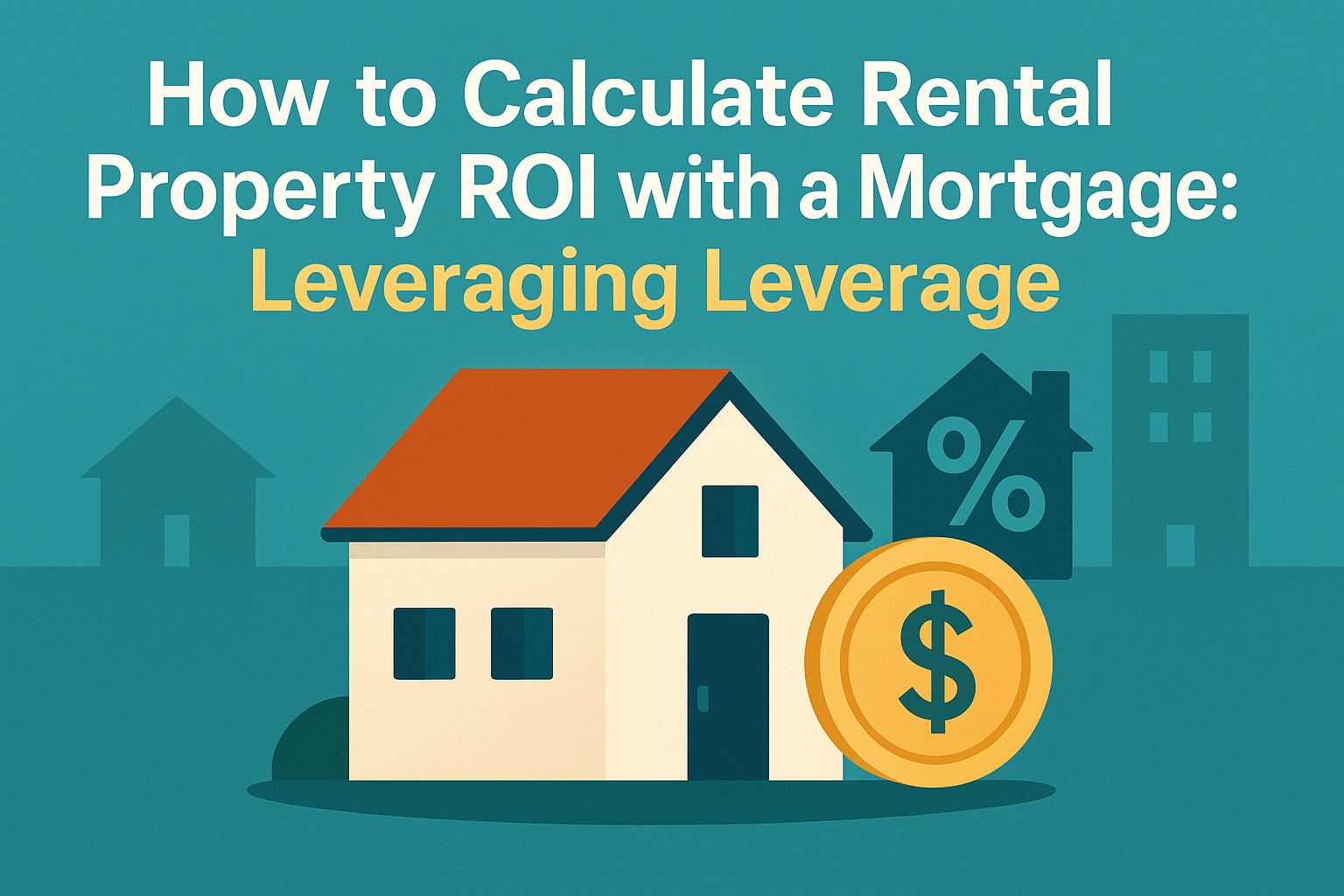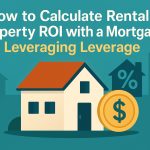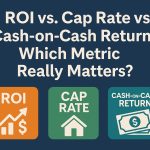1. Introduction: Harnessing Leverage for Higher Returns
When you finance a rental property instead of paying all cash, you’re using other people’s money to magnify your potential gains—or losses. Leverage lets you control a larger asset with a smaller upfront investment, freeing up capital to pursue additional deals. At the same time, mortgage payments add a fixed cost that can eat into your cash flow if rents fall or unexpected expenses arise.
In this article, you’ll learn exactly how to factor a mortgage into your ROI calculation. We’ll start by reviewing the “all-cash” ROI you already know, then show you how to adjust for debt service and principal pay-down. Along the way, you’ll discover:
- Why a property that looks mediocre on an all-cash basis can deliver stellar returns when partially financed.
- How to build a levered ROI formula that reflects both your actual cash outlay and the annual equity you gain.
- When high leverage makes sense—and when it turns a good deal into a financial trap.
By the end, you’ll have a clear, step-by-step process for calculating leveraged ROI, so you can compare all-cash and financed scenarios side by side, stress-test sensitivity to interest rates, and make confident choices about when—and how much—to borrow.
2. Unleveraged vs. Leveraged ROI: Key Distinctions
Your unleveraged ROI formula is simple: you subtract all expenses from your rental income, then divide by the total cash you invested. That gives you a pure measure of how well the property itself generates profit. But when you introduce a loan, two major changes occur:
- Debt Service Reduces Cash Flow
Every mortgage payment is deducted from the Net Operating Income (NOI) before you get a check in your hand. - Principal Pay-Down Builds Equity
A portion of each payment increases your ownership stake, effectively “forcing” savings that aren’t reflected in your annual cash flow.
To capture both effects, your leveraged ROI formula becomes:
mathematicaCopyEditLeveraged ROI (%) = (Annual Cash Flow + Annual Principal Pay-Down) ÷ Total Cash Invested × 100
- Annual Cash Flow = NOI – Annual Debt Service
- Annual Principal Pay-Down = Sum of all principal portions in your 12 mortgage payments
- Total Cash Invested = Down Payment + Closing Costs + Initial Repairs
Example Comparison:
- All-Cash Scenario:
- Purchase Price: $300,000
- Total Cash Invested: $300,000 + $7,000 closing + $8,000 repairs = $315,000
- NOI: $30,000
- Unleveraged ROI: $30,000 ÷ $315,000 ≈ 9.5%
- 75% LTV Mortgage Scenario:
- Loan Amount: $225,000 at 4% over 30 years → Annual Debt Service ≈ $12,960
- Down Payment + Costs: $75,000 + $7,000 + $8,000 = $90,000
- Annual Cash Flow: $30,000 – $12,960 = $17,040
- Annual Principal Pay-Down: ≈ $2,200 in year one
- Total Cash Return: $17,040 + $2,200 = $19,240
- Leveraged ROI: $19,240 ÷ $90,000 ≈ 21.4%
In this example, leverage more than doubles your ROI—transforming a 9.5% unleveraged return into over 21% on your actual cash outlay.
3. Mortgage Fundamentals Every Investor Must Know
Before you plug numbers into your levered ROI calculator, make sure you understand the three mortgage parameters that move the numbers most:
- Down Payment & Loan-to-Value (LTV):
The down payment determines how much cash you need up front and your LTV ratio (loan amount ÷ purchase price). A higher LTV means less cash invested—and a smaller denominator in your ROI formula—but also higher monthly payments and greater sensitivity to interest rate changes. - Interest Rate & Amortization Term:
Your interest rate and loan term set your monthly debt service. Lower rates and longer terms reduce your annual mortgage costs, boosting cash flow (but delaying equity build-up). Conversely, shorter terms raise cash flow burdens but accelerate principal pay-down, increasing that portion of your ROI. - Closing Costs & Financing Fees:
Don’t forget lender fees, origination charges, appraisal costs, points, and any mortgage insurance premiums. All these belong in your Total Cash Invested tally. Skipping them understates your true out-of-pocket cost and overstates your leveraged ROI.
When you combine these factors into a single calculation, you capture the full story:
- Your Annual Cash Flow after paying debt service.
- Your Forced Savings in the form of principal pay-down.
- Your True Cash Outlay including every financing expense.
With these fundamentals in hand, you’re ready to build a dynamic ROI model that lets you tweak down payment percentages, test different rates and terms, and see exactly how each choice impacts your return.
4. Step-by-Step Leveraged ROI Calculation Walkthrough
Let’s walk through a detailed, real-world example that combines all the pieces you’ve learned so far.
- Gather Your Inputs
- Purchase Price: $300,000
- Down Payment: 20% → $60,000
- Closing Costs + Repairs: $10,000
- Financed Amount: $240,000 at 4.5% interest over 30 years
- Gross Annual Rent: $36,000
- Operating Expenses: 25% of rent → $9,000
- Compute Net Operating Income (NOI) nginxCopyEdit
NOI = Gross Rent – Operating Expenses = \$36,000 – \$9,000 = \$27,000 - Calculate Annual Debt Service
Using a standard mortgage formula, the monthly payment on $240,000 at 4.5% over 30 years is about $1,216. nginxCopyEditAnnual Debt Service = \$1,216 × 12 = \$14,592 - Determine Annual Cash Flow nginxCopyEdit
Annual Cash Flow = NOI – Annual Debt Service = \$27,000 – \$14,592 = \$12,408 - Compute Annual Principal Pay-Down
In year one, roughly 20% of each payment goes to principal. nginxCopyEditPrincipal Portion ≈ 20% × \$14,592 = \$2,918 - Total Cash Invested nginxCopyEdit
Cash Invested = Down Payment + Closing Costs + Repairs = \$60,000 + \$10,000 = \$70,000 - Leveraged ROI Formula matlabCopyEdit
Leveraged ROI (%) = (Annual Cash Flow + Principal Pay-Down) ÷ Cash Invested × 100 = (12,408 + 2,918) ÷ 70,000 × 100 ≈ 21.8%
Key Insight: Compared to an all-cash ROI of
\$27,000 ÷ \$310,000 ≈ 8.7%, leverage more than doubles your effective return on the actual cash you put down.
5. Building a Dynamic Leveraged ROI Model
A flexible spreadsheet lets you instantly see how different financing scenarios affect your returns.
- Set Up Your Columns
- Purchase Price
- Down Payment %
- Interest Rate
- Loan Term
- Closing & Repair Costs
- Gross Rent
- Expense Ratio
- Automate Calculations with Formulas
- NOI:
=GrossRent*(1-ExpenseRatio) - Monthly Payment: use the mortgage-payment function (e.g.,
=PMT(Interest/12,Term*12,-LoanAmount)) - Annual Debt Service:
=MonthlyPayment*12 - Annual Cash Flow:
=NOI–AnnualDebtService - Principal Pay-Down: estimate year-1 principal via amortization schedule or approximate percentage of debt service
- Leveraged ROI: as above
- NOI:
- Scenario Analysis Tabs
- Base Case: your target market assumptions
- Rate Shock: simulate a +1% interest rate increase
- Rent Adjustment: model a 5% rent decrease or 10% vacancy spike
- Down Payment Variations: test 10%, 20%, and 30% equity scenarios
- Visualize Results
- Data Table: show ROI outcomes for each scenario
- Chart: plot ROI vs. down payment or ROI vs. interest rate
With this model, you can instantly answer questions like “If rates tick up to 5.5%, does my leveraged ROI remain above 15%?” or “What’s the minimum down payment to hit my 20% ROI target?”
6. When Leverage Backfires: Risk Management
Leverage can supercharge gains—but it also amplifies problems if things go wrong. Guard against common pitfalls:
- Interest-Rate Risk
- Adjustable-Rate Mortgages: sudden rate resets can spike debt service.
- Mitigation: secure a fixed-rate loan or build a rate-shock buffer into your model.
- Vacancy & Rent Shortfalls
- A 10–15% vacancy can turn positive cash flow into a loss.
- Mitigation: maintain a 6–9-month cash reserve; stress-test for higher vacancy in your spreadsheet.
- Overleveraging
- Extremely low down payments (e.g., 90–95% LTV) leave little equity cushion and can trigger lender margin calls.
- Mitigation: target 65–75% LTV to balance cash-on-cash returns with safety.
- Unexpected Expenses
- Major repairs (roof, HVAC) can wipe out your reserve and cash flow.
- Mitigation: allocate 5–10% of rent to a capital expenditures reserve line item.
- Refinancing Risks
- If you plan to refinance after value-add, higher rates or tighter lending standards may block your exit.
- Mitigation: have a contingency plan—either sell or hold at your current financing.
By proactively modeling these risks and embedding conservative assumptions in your leveraged ROI model, you ensure the upside of leverage without falling prey to its hidden downsides.
4. Step-by-Step Leveraged ROI Calculation Walkthrough
Let’s walk through a detailed, real-world example that combines all the pieces you’ve learned so far.
- Gather Your Inputs
- Purchase Price: $300,000
- Down Payment: 20% → $60,000
- Closing Costs + Repairs: $10,000
- Financed Amount: $240,000 at 4.5% interest over 30 years
- Gross Annual Rent: $36,000
- Operating Expenses: 25% of rent → $9,000
- Compute Net Operating Income (NOI) nginxCopyEdit
NOI = Gross Rent – Operating Expenses = \$36,000 – \$9,000 = \$27,000 - Calculate Annual Debt Service
Using a standard mortgage formula, the monthly payment on $240,000 at 4.5% over 30 years is about $1,216. nginxCopyEditAnnual Debt Service = \$1,216 × 12 = \$14,592 - Determine Annual Cash Flow nginxCopyEdit
Annual Cash Flow = NOI – Annual Debt Service = \$27,000 – \$14,592 = \$12,408 - Compute Annual Principal Pay-Down
In year one, roughly 20% of each payment goes to principal. nginxCopyEditPrincipal Portion ≈ 20% × \$14,592 = \$2,918 - Total Cash Invested nginxCopyEdit
Cash Invested = Down Payment + Closing Costs + Repairs = \$60,000 + \$10,000 = \$70,000 - Leveraged ROI Formula matlabCopyEdit
Leveraged ROI (%) = (Annual Cash Flow + Principal Pay-Down) ÷ Cash Invested × 100 = (12,408 + 2,918) ÷ 70,000 × 100 ≈ 21.8%
Key Insight: Compared to an all-cash ROI of
\$27,000 ÷ \$310,000 ≈ 8.7%, leverage more than doubles your effective return on the actual cash you put down.
5. Building a Dynamic Leveraged ROI Model
A flexible spreadsheet lets you instantly see how different financing scenarios affect your returns.
- Set Up Your Columns
- Purchase Price
- Down Payment %
- Interest Rate
- Loan Term
- Closing & Repair Costs
- Gross Rent
- Expense Ratio
- Automate Calculations with Formulas
- NOI:
=GrossRent*(1-ExpenseRatio) - Monthly Payment: use the mortgage-payment function (e.g.,
=PMT(Interest/12,Term*12,-LoanAmount)) - Annual Debt Service:
=MonthlyPayment*12 - Annual Cash Flow:
=NOI–AnnualDebtService - Principal Pay-Down: estimate year-1 principal via amortization schedule or approximate percentage of debt service
- Leveraged ROI: as above
- NOI:
- Scenario Analysis Tabs
- Base Case: your target market assumptions
- Rate Shock: simulate a +1% interest rate increase
- Rent Adjustment: model a 5% rent decrease or 10% vacancy spike
- Down Payment Variations: test 10%, 20%, and 30% equity scenarios
- Visualize Results
- Data Table: show ROI outcomes for each scenario
- Chart: plot ROI vs. down payment or ROI vs. interest rate
With this model, you can instantly answer questions like “If rates tick up to 5.5%, does my leveraged ROI remain above 15%?” or “What’s the minimum down payment to hit my 20% ROI target?”
6. When Leverage Backfires: Risk Management
Leverage can supercharge gains—but it also amplifies problems if things go wrong. Guard against common pitfalls:
- Interest-Rate Risk
- Adjustable-Rate Mortgages: sudden rate resets can spike debt service.
- Mitigation: secure a fixed-rate loan or build a rate-shock buffer into your model.
- Vacancy & Rent Shortfalls
- A 10–15% vacancy can turn positive cash flow into a loss.
- Mitigation: maintain a 6–9-month cash reserve; stress-test for higher vacancy in your spreadsheet.
- Overleveraging
- Extremely low down payments (e.g., 90–95% LTV) leave little equity cushion and can trigger lender margin calls.
- Mitigation: target 65–75% LTV to balance cash-on-cash returns with safety.
- Unexpected Expenses
- Major repairs (roof, HVAC) can wipe out your reserve and cash flow.
- Mitigation: allocate 5–10% of rent to a capital expenditures reserve line item.
- Refinancing Risks
- If you plan to refinance after value-add, higher rates or tighter lending standards may block your exit.
- Mitigation: have a contingency plan—either sell or hold at your current financing.
By proactively modeling these risks and embedding conservative assumptions in your leveraged ROI model, you ensure the upside of leverage without falling prey to its hidden downsides.
7. Sensitivity Analysis: Stress-Testing Your Leveraged ROI
Understanding how small changes in your assumptions can swing your returns is vital when you’re using debt to amplify gains. In this section, we’ll build on your leveraged ROI model to introduce “what-if” scenarios, helping you anticipate worst-case, base-case, and best-case outcomes.
7.1 Interest-Rate Shock
- Scenario Setup: Increase your mortgage rate by 1% (for example, from 4.5% to 5.5%).
- Impact on Debt Service:
- Re-calculate your monthly payment using the higher rate.
- Observe how annual debt service climbs and how that reduces your annual cash flow.
- ROI Effect:
- Recompute leveraged ROI with the new debt service. A move from 4.5% to 5.5% might cut your ROI by several percentage points—especially in the early years when interest makes up a larger share of each payment.
7.2 Vacancy and Rent Fluctuations
- Scenario Setup A: Model a 10% vacancy rate (instead of 5%).
- Scenario Setup B: Assume rents decline by 5% due to market softness.
- Impact on NOI:
- Reduce gross rent accordingly, then subtract the same operating-cost percentage to get revised NOI.
- Cash-Flow Implications:
- See whether your annual cash flow stays positive after debt service.
- ROI Implications:
- A small rent dip or vacancy surge can flip a highly leveraged deal from a 20%+ ROI to a negative return.
7.3 Unexpected Repair Surge
- Scenario Setup: A major roof repair or HVAC replacement costs $15,000 in year two.
- Impact on Cash Flow:
- Treat this as a one-time expense, reducing that year’s cash flow (and overall net profit).
- ROI Implications:
- Because leveraged ROI includes both cash flow and principal pay-down, a large surprise expense can temporarily depress your ROI, even if future years bounce back.
7.4 Visualizing the Range
- Data Table: Create a small table showing leveraged ROI under each scenario (base, +1% rate, +10% vacancy, large repair).
- Line Chart: Plot ROI over a five-year hold for each scenario, so you see how quickly—or whether—your returns recover after a stress event.
By building sensitivity analysis directly into your spreadsheet, you’ll never be caught off-guard by rising rates or unexpected expenses. Instead, you’ll enter each deal with a clear understanding of the possible upside—and the downside you can tolerate.
8. Incorporating Tax Benefits & Depreciation into Leveraged ROI
Debt not only amplifies your cash returns but also unlocks tax advantages that can further boost your after-tax ROI. In this section, we’ll layer in depreciation deductions, mortgage interest write-offs, and other incentives to show you how to calculate a more complete, after-tax leveraged ROI.
8.1 Depreciation: A Non-Cash Deduction
- Residential Depreciation Schedule: Spread the building’s depreciable basis (purchase price minus land value) evenly over 27.5 years.
- Annual Depreciation Expense: nginxCopyEdit
Depreciable Basis ÷ 27.5 = Annual DepreciationFor example, if your building basis is $200,000, annual depreciation is about $7,273. - Tax Shield Effect: This non-cash expense reduces your taxable rental profit, lowering your actual tax bill without affecting cash flow.
8.2 Mortgage Interest Deduction
- Interest vs. Principal: In early years, the majority of your mortgage payment is interest, which is fully deductible against rental income.
- Taxable Income Reduction: Subtract total interest paid from your NOI (after depreciation) to arrive at your taxable rental net income—and thus your lower tax liability.
8.3 Calculating After-Tax Cash Flow
- Start with NOI (as before).
- Subtract Annual Debt Service to get pre-tax cash flow.
- Add Back Depreciation (since it’s a non-cash deduction).
- Subtract Interest Portion to determine taxable income.
- Apply Your Marginal Tax Rate (e.g., 24%) to compute taxes owed.
- Final After-Tax Cash Flow = Pre-tax Cash Flow + Depreciation – (Taxable Income × Tax Rate).
8.4 After-Tax Leveraged ROI Formula
mathematicaCopyEditAfter-Tax ROI (%) = (After-Tax Cash Flow + Principal Pay-Down) ÷ Total Cash Invested × 100
- Principal Pay-Down: Remains part of your forced savings.
- Total Cash Invested: Includes down payment, closing costs, repairs, and any upfront fees.
8.5 Worked Example
- Base Inputs: Same as our earlier $300,000 example, with $27,000 NOI, $14,592 debt service, and $2,918 principal pay-down.
- Depreciation: $7,273
- Interest Paid (Year One): Roughly $10,170
- Pre-Tax Cash Flow: $12,408
- Taxable Income: $12,408 – $7,273 – $10,170 = –$5,035 (a loss, creating a tax shelter)
- Tax Savings: –$5,035 × 24% = –$1,209 (i.e., you save $1,209 in taxes)
- After-Tax Cash Flow: $12,408 + $7,273 + $1,209 = $20,890
- After-Tax Leveraged ROI: scssCopyEdit
(20,890 + 2,918) ÷ 70,000 × 100 ≈ 34.6%
Thanks to depreciation and interest deductions, your after-tax leveraged ROI jumps dramatically—highlighting why savvy investors structure deals to maximize these benefits.
9. Conclusion: Balancing Leverage for Maximum Reward and Manageable Risk
Leverage is a double-edged sword: it can catapult your returns into the stratosphere, but it also magnifies every hiccup—rate hikes, vacancies, repairs—that comes your way. By following a disciplined, multi-step process you’ll be equipped to:
- Calculate Leveraged ROI accurately, capturing both cash flow and principal pay-down.
- Stress-Test Your Assumptions with sensitivity scenarios that reveal the true upside and downside.
- Layer in Tax Advantages like depreciation and mortgage interest deductions to compute an after-tax return.
- Monitor Your Metrics Continuously, updating your model whenever interest rates move, expenses change, or rents adjust.
Key Takeaways:
- Lower down payments boost your percentage ROI but increase your exposure to rising rates and slower equity growth.
- Stress-testing bookmarks your comfort zone: know before you buy whether a 1% rate jump or 10% vacancy turns a deal sour.
- Tax-sheltering through depreciation can turn paper losses into real cash savings, supercharging your net returns.
Armed with this comprehensive framework, you’ll not only spot the best deals but also structure financing in a way that aligns with your goals—whether that’s aggressive growth, reliable income, or a balanced combination of both. Now, open your spreadsheet model, plug in today’s rates and rent projections, and start comparing leveraged scenarios with confidence. Your next high-return rental property is waiting—go seize it.








